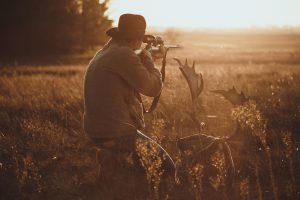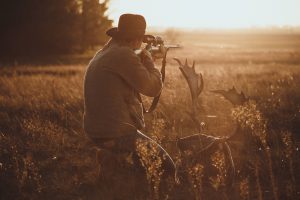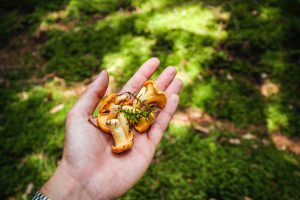Surviving the Wilderness through Hunting and Gathering

Hunting and Gathering is a form of human adaptation and is the oldest and most extensive in terms of time and space. A hunter-gatherer is a person who lives in a community where most or all of the food is obtained from forage, that is, gathering wild plants and hunting wild animals. Ancient humans were hunters and gatherers from around 2.5 million years ago when stone tools first appeared in archeological records. In this way, humans are hunters and gatherers for much of human evolution.
However, technological development was relatively slow until evolution progressed around 100,000 years ago. Although ancient humans hunted animals and collected plant resources, it is hard to know exactly how they lived.
Photo by Derek Malou on Unsplash
Toolkit of Hunter-Gatherers
Most kits of hunter-gatherers are quite simple. Many individuals use small arms, rifles, guns, bows and arrows, and knives to hunt the animals. Some tools are far more complex than the usual ones. You can check out some fantastic collections on Shrewd Hunters Buying Guide for excellent deals and offers.
To hunt and gather successfully, extensive knowledge of natural history and good physical endurance is required. It is essential to recognize a large number of plant and animal species and understand animal behavior and patterns of plant growth, flowering, and fruiting.
Plant products provide the most calories, while fish and meat provide the most protein. Collecting plants also requires technical skills and background knowledge of history.
Ways of Hunting Animals
Hunting techniques vary depending on the game and its habitat. You must follow strict rules while using tools and hunting. There are several ways to hunt your prey, such as:
Still Hunting
Still hunting continues to be a standard hunting method for killing large animals such as deer, bears, and wild boar. However, still hunting requires a lot of skill and time.
Still hunting is done by tracking animals, finding traces, etc. You need to follow this sign very carefully. When following animal tracks, it is essential to walk very cautiously while continually looking out for your prey.
Calling Method
Calling methods can be a very effective hunting technique. You can use various devices to produce the sound of the animal you are chasing. Calls to the game are beneficial during the breeding season of the desired type.
For instance, the most frequent calls for deer hunting are screams and rattles of horns.
Baiting Method
Although baiting is a popular and very effective way to hunt different animal species, it is essential to review local laws to ensure that the baiting method is legal in your region. While most places allow bait, some areas still consider it illegal. The technique is quite simple; you can use artificial food sources near your hunting grounds to attract animals.
Photo by Nico Benedickt on Unsplash
Ways of Gathering Wild Plants & Fruits
The first step to gathering wild fruits and plants is learning how to recognize which one you can eat and what you shouldn’t eat. Before you start assembling the wild edibles, you must know what to look for, where to find it, and how to use it after taking it home. Popular wild edibles include various types of green fruits, berries, roots, nuts, and mushrooms.
Mushrooms
Wild mushrooms can be delicious, but can also be very dangerous. It can be tough to know which mushroom is edible if you are a novice in gathering. Many wild mushrooms contain deadly poisons, and you need to stay far away from them.
Hence, if you wish to gather wild mushrooms, it’s essential to practice with an expert before you start on your own and always carry a field guide to help you identify the edibles. Also, it is best to try a small portion of the gathered mushroom first and wait a day or two to ensure there is no allergic reaction.
An example of wild mushrooms is morels. They are very popular and can only be found in wild nature, and you cannot even plant them. They occur throughout the continent in the spring months, usually in and around the forest’s edge. They often grow around dead or dying trees, especially elm trees. Morel mushrooms are easily recognized by the pointed brown lid attached to the base of the stem. However, beginners must be careful while gathering them.
Nuts
Wild green fruits and berries are delicious, but they don’t provide many calories. You can fill your food by adding wild nuts like acorns. They are commonly found around all of North America in the autumn months and are edible. However, acorns need to be processed before eating because it is full of tannins, which give an extraordinarily bitter taste, and can damage your kidneys.
Fruits
Fruits are quick to gather because you can pull them directly from a tree or bush. To take an example, Mulberries grow on trees in the eastern United States.
There are three varieties of mulberries:
- Red: It has the most definite aroma
- Black: It has a soft and sweet taste
- White: It has a slightly acidic taste with a hint of vanilla
Vegetables
Many plants that are considered weeds can make delicious salads. For example, Stinging Nettle is a tall, thorny plant with small white flowers that are often found along rivers and in moist forest areas. Gathering them requires protective clothing because little, sharp hair can penetrate your skin and release formic acid, causing itching or burning. Once the leaves are ripe, the stinging hair falls out, and they are a good substitute for spinach in soups and stews.
The Paleo Diet
The Paleolithic Diet is a diet chart based on foods similar to those consumed during the Paleolithic period, around 2.5 million to 10,000 years ago.
Paleo diets usually include lean meat, fish, fruits, vegetables, nuts, and seeds – food that can be obtained by hunting and gathering. These foods include dairy products, nuts, and cereals. Other names for the Paleo Diet are the Stone Age Diet and the Caveman Diet.
Conclusion
Hunting and Gathering for food is an immensely fun activity. Walking in the jungle to hunt animals or gather berries contributes to a great natural form of training and helps you stay fit.
Surviving the Wilderness through Hunting and Gathering
appeared first on Survival Frog Blog.


